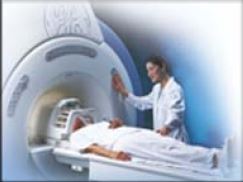| Line 4: | Line 4: | ||
[[Link title]] | [[Link title]] | ||
<center><font size="5"></font> | <center><font size="5"></font> | ||
| − | <font size="5"> | + | <font size="5">Magnetic Resonance Imaging (MRI)</font> |
A [https://www.projectrhea.org/learning/slectures.php slecture] by [[ECE]] student Sahil Sanghani | A [https://www.projectrhea.org/learning/slectures.php slecture] by [[ECE]] student Sahil Sanghani | ||
| Line 10: | Line 10: | ||
Partly based on the ECE 637 material of Professor Bouman. | Partly based on the ECE 637 material of Professor Bouman. | ||
</center> | </center> | ||
| − | = | + | ---- |
| + | =Introduction= | ||
| + | Magnetic Resonance Imaging (MRI) is a different mode of imaging from the previously discussed ones. It is characterized by using changing magnetic fields and RF waves to selectively resonate areas of interest for imaging. MRI does not use ionizing radiation like CT does, and it is very flexible and adaptable. It can be reprogrammed to fit specific needs. It is also very high in resolution with normal scans having a resolution on the order of millimeters. Theoretically the only bound on the resolution is the length of the scan. This quality has its trade-offs. MRI is very expensive and the length of the scan is long. The machine is also noisy. | ||
| + | [[Image: MRI_scanner.jpg|400px|thumb|left|Fig 1: An MRI Scanner]] | ||
| + | |||
| + | ---- | ||
| + | =Magnetic Resonance= | ||
| + | |||
| + | ---- | ||
| + | =MRI Hardware= | ||
| + | =Magnetic Field Gradients= | ||
| + | =MRI Slice Selection= | ||
| + | =Slice Selection Pulse Design= | ||
| + | =Signal Analysis on a Single Voxel= | ||
| + | =Scaling Signal Analysis to a Slice= | ||
Put your content here . . . | Put your content here . . . | ||
Revision as of 21:51, 21 December 2014
Magnetic Resonance Imaging (MRI)
A slecture by ECE student Sahil Sanghani
Partly based on the ECE 637 material of Professor Bouman.
Contents
Introduction
Magnetic Resonance Imaging (MRI) is a different mode of imaging from the previously discussed ones. It is characterized by using changing magnetic fields and RF waves to selectively resonate areas of interest for imaging. MRI does not use ionizing radiation like CT does, and it is very flexible and adaptable. It can be reprogrammed to fit specific needs. It is also very high in resolution with normal scans having a resolution on the order of millimeters. Theoretically the only bound on the resolution is the length of the scan. This quality has its trade-offs. MRI is very expensive and the length of the scan is long. The machine is also noisy.
Magnetic Resonance
MRI Hardware
Magnetic Field Gradients
MRI Slice Selection
Slice Selection Pulse Design
Signal Analysis on a Single Voxel
Scaling Signal Analysis to a Slice
Put your content here . . .
References:
[1] C. A. Bouman. ECE 637. Class Lecture. Digital Image Processing I. Faculty of Electrical Engineering, Purdue University. Spring 2013.


